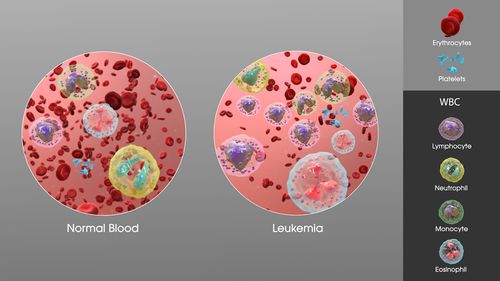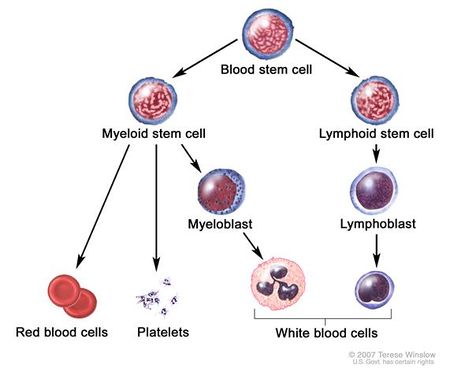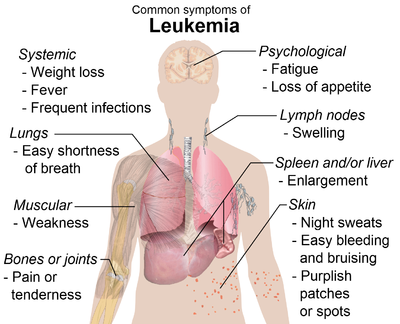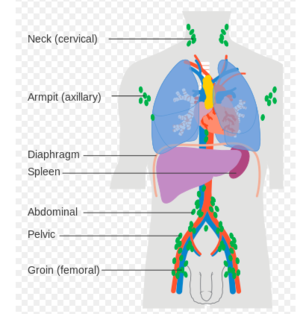Leukemia
Original Editor - User:Lucinda hampton
Top Contributors - Lucinda hampton, Kim Jackson, Vidya Acharya, Kapil Narale and Aya Alhindi
Introduction[edit | edit source]
Leukemia is a cancer of the early blood-forming cells.
- Most often, leukemia is a cancer of the white blood cells, but some leukemias start in other blood cell types.
- There are several types of leukemia, which are divided based mainly on whether the leukemia is acute (fast growing) or chronic (slower growing), and whether it starts in myeloid cells or lymphoid cells[1].
- Different types of leukemia have different treatment options and outlooks. .[2]
- Leukemia is actually hundreds of different diseases on a molecular level, with no two leukemias being exactly alike.
Image at R: 3D Medical Animation still showing an increase in white blood cells of a person suffering from Leukemia.
Pathophysiology[edit | edit source]
Bone marrow is responsible for the making of red blood cells (RBC), white blood cells (WBC) and platelets.
In leukaemia, due to the immature cells or some defect in the cells of the bone marrow, the abnormal and functionless WBC are produced which are unable to fight against the infection and defend the body against foreign substances.
Also, they obstruct the production of other blood cells by dividing quickly and crowding among normal cells.
Myelogenous vs. Lymphocytic Leukemia
All of the blood cells derive from pluripotential stem cells in the bone marrow thanks to a process called hematopoiesis. These cells differentiate into either
- Myeloid cells (the myeloid cell line). Myeloid cells differentiate into red blood cells, platelets, and the type of cells found in myeloid leukemia: neutrophils, monocytes, and more.
- Lymphoid cells differentiate into either B lymphocytes (B cells) or T lymphocytes (T cells), and lymphocytic leukemias may begin in either of these cell types.
Acute or Chronic
- Acute leukemias arise from immature cells in the bone marrow (myeloblasts or lymphoblasts). These cells do not function like fully mature ones in fighting off infections. In addition, they often crowd the bone marrow, preventing the production of other blood cells such as red blood cells, other white blood cells, and platelets. Without treatment, acute leukemias often progress very rapidly.
- Chronic leukemia arises from mature, but abnormal white blood cells. These cancers grow much more slowly and may be discovered accidentally when a blood count is done for another reason[2].[3]
Types[edit | edit source]
The major types of leukemia are:
- Acute lymphocytic leukemia (ALL). This is the most common type of leukemia in young children. ALL can also occur in adults.
- Acute myelogenous leukemia (AML). AML is a common type of leukemia. It occurs in children and adults. AML is the most common type of acute leukemia in adults.
- Chronic lymphocytic leukemia (CLL). With CLL, the most common chronic adult leukemia, you may feel well for years without needing treatment.
- Chronic myelogenous leukemia (CML). This type of leukemia mainly affects adults. A person with CML may have few or no symptoms for months or years before entering a phase in which the leukemia cells grow more quickly.
- Other types. Other, rarer types of leukemia exist, including hairy cell leukemia, myelodysplastic syndromes and myeloproliferative disorders[4].
Symptoms[edit | edit source]
The symptoms of leukaemia may be mild at first but later certain symptoms do occur like the following: Anemia; Swollen lymph nodes; Bleeding from gums or in stool; Fatigue; Frequent infection; Excessive sweating; Bone tenderness; Sudden weight loss; Fever; Easy bruises; Seizures and headache (if it spreads to the central nervous system); Loss of muscle control; Enlarged liver or spleen.[3]
Causes[edit | edit source]
The possible causes and risk factors for leukemia vary between the different forms of the disease.
- Radiation exposure is one of the better-studied risk factors and can include radiation related to atomic bombs, nuclear accidents, medical radiation therapy, and radiation related to diagnostic procedures such as CT scans.
- Home and environmental exposures to chemicals such as benzene (found in paints, solvents, gasoline, and more) have also been linked with leukemia.
- Smoking is a significant risk factor for AML, and leukemia may be more common in children whose parents smoked during pregnancy.
- ALL is more common in children, especially those under age 5 years, while CLL and CML are more common in older adults.
- Infection with the human T-cell leukemia virus (HTLV-1) is also a significant risk factor for leukemia, but is uncommon in the United States.
- Some medical conditions (such as myelodysplastic syndromes ) as well as previous chemotherapy increase risk.
- There are several possible risk factors that are being investigated as well, such as certain dietary practices and radon exposure in the home.
- A family history of the disease increases the risk with CLL, but appears to have little role in CML and ALL. Some genetic syndromes, such as Down syndrome and Fanconi anemia elevate risk as well.
Diagnosis[edit | edit source]
- There are several symptoms of leukaemia which are similar to other disorders.
- A proper medical examination is necessary.
The tests for diagnosing leukaemia are as follows:
- Complete blood count test: To determine the count of WBCs, RBCs and platelets in the bloodstream or the formation of any abnormal cells.
- Tissue biopsy scan: A test in which a small tissue is taken from the lymph nodes or bone marrow to identify the presence of leukaemia, its type and its growth rate.
- Genetic abnormality test: A test to determine the Philadelphia chromosome, genetic defect present in leukaemia cells.
- Staging: This test helps determine the outlook of the patient based on the type of leukaemia.
- Cytochemistry: A test in which stains are used to identify the tissue structure of the bone marrow cells.
- Lumbar puncture: A test performed by the spinal fluid to identify the spread of the leukaemia to the central nervous system.
- Other methods of diagnosing include CT scan, MRI and ultrasound.
Treatment[edit | edit source]
The treatments include:
- Radiation therapy: Here, high energy beams or X-rays are used to inhibit the growth of leukaemia cells.
- Chemotherapy: In this method, a single or combination of drugs are used to treat leukaemia.
- Targeted therapy: Here, specific drugs are used to control certain vulnerabilities of the leukaemia cells or to halt certain function of the leukaemia cells which prevents its further growth.
- Stem cell transplant: A treatment in which diseased bone marrow is replaced with healthy bone marrow.
- Biological therapy: This treatment includes antibodies, cytokines and tumour vaccines which help the immune system to identify the cancerous cells and attack them.
- Other treatment method include: Blood or platelet transfusions; Antiviral or antibiotics medications; Vaccines against flu; Anti-nausea drugs; Immunoglobulins injections[3]
Leukemia vs. Lymphoma: What’s the Difference?[edit | edit source]
Leukemia and lymphoma are types of blood cancer. It’s estimated that in 2016 in the United States, approximately
- 60000 people will be diagnosed with leukemia
- 80000 people will be diagnosed with lymphoma. At R: Diagram showing the lymph nodes lymphoma most commonly develops in.
While the two cancers share certain symptoms, there are some differences in their origins, symptoms, and treatments.
- Lymphoma is cancer that begins in infection-fighting cells of the immune system, called lymphocytes. These cells are in the lymph nodes, spleen, thymus, bone marrow, and other parts of the body. In lymphoma, lymphocytes change and grow out of control.
There are two main types of lymphoma:
- Non-Hodgkin: Most people with lymphoma have this type.
- Hodgkin
Non-Hodgkin and Hodgkin lymphoma involve different types of lymphocyte cells.[5]
- While the lymphatic tissue can be a primary site for cancer (e.g. lymphoma), it is more commonly a pathway for a metastatic process.
- The other major pathway for cancer spreading is through the bloodstream.
References[edit | edit source]
- ↑ ACS Leukemia Available from:https://www.cancer.org/cancer/leukemia.html (last accessed 16.7.2020)
- ↑ 2.0 2.1 Very well health Leukemia Available from:https://www.verywellhealth.com/leukemia-overview-514157 (last accessed 16.7.2020)
- ↑ 3.0 3.1 3.2 Boldsky Leukemia Available from:https://www.boldsky.com/health/disorders-cure/leukaemia-causes-types-symptoms-complications-treatment-prevention-130098.html (last accessed 16.7.2020)
- ↑ Mayo clinic Leukemia Available from:https://www.mayoclinic.org/diseases-conditions/leukemia/symptoms-causes/syc-20374373 (last accessed 16.7.2020)
- ↑ webmd Lymphoma Available from:https://www.webmd.com/cancer/lymphoma/lymphoma-cancer#1 (last accessed 16.7.2020)










